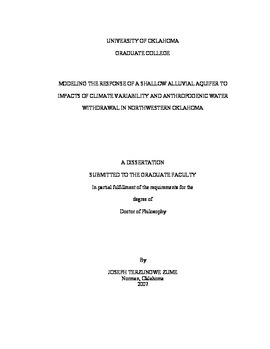| dc.contributor.advisor | Tarhule, Aondover, | en_US |
| dc.contributor.author | Zume, Joseph Terzungwe. | en_US |
| dc.date.accessioned | 2013-08-16T12:20:39Z | |
| dc.date.available | 2013-08-16T12:20:39Z | |
| dc.date.issued | 2007 | en_US |
| dc.identifier.uri | https://hdl.handle.net/11244/1192 | |
| dc.description.abstract | Alluvial aquifers are the most reliable sources of water for human consumptive uses and for sustaining riparian ecosystems in semiarid environments. Regardless, very little is known about their dynamics relative to bedrock aquifers. For example, it is not entirely clear how alluvial aquifers respond to impacts of climate variability and change. Similarly, the question about how pumping these aquifers impact stream-aquifer interactions has not been fully explored. This dissertation explores the dynamics within the alluvium and terrace (A&T) aquifer of the Beaver-North Canadian River (BNCR) in semiarid northwestern Oklahoma. The study includes three self-contained but related studies; (1) an analysis of northwestern Oklahoma precipitation and streamflow time-series for trends and periodicities; (2) an investigation of the impacts of groundwater pumping on stream-aquifer interactions within the alluvial basin, and (3) a numerical simulation of the response of the alluvial aquifer to various scenarios of climate variability and anthropogenic groundwater pumping. The numerical simulation is accomplished using a three-dimensional groundwater flow model, MODFLOW. | en_US |
| dc.description.abstract | Broadly, results of this study indicate that the combined impacts of anthropogenic pumping and climate variability will create drawdown of greater than 12 m in the alluvial aquifer. Spatially however, areas of high drawdown will be localized, driven primarily by the intensity of pumping from well clusters. The worst impacts both from anthropogenic and climatic stresses will be on stream-aquifer interactions. Anthropogenic pumping for example, depletes streamflow by intercepting baseflow to streams, while, at the same time, inducing higher leakage from the streams into the aquifer. Climate, on the other hand, controls the amount of recharge to the stream-aquifer system. Thus, by simulating various anthropogenic and climatic stress scenarios on the study aquifer, this research provides information that can be used for evaluating competing aquifer management options. | en_US |
| dc.format.extent | xiv, 160 leaves : | en_US |
| dc.subject | Hydrology. | en_US |
| dc.subject | Climatic changes Environmental aspects Oklahoma. | en_US |
| dc.subject | Geography. | en_US |
| dc.subject | Aquifers Oklahoma. | en_US |
| dc.subject | Groundwater Oklahoma. | en_US |
| dc.title | Modeling the response of a shallow alluvial aquifer to impacts of climate variability and anthropogenic water withdrawal in northwestern Oklahoma. | en_US |
| dc.type | Thesis | en_US |
| dc.thesis.degree | Ph.D. | en_US |
| dc.thesis.degreeDiscipline | Department of Geography and Environmental Sustainability | en_US |
| dc.note | Adviser: Aondover Tarhule. | en_US |
| dc.note | Source: Dissertation Abstracts International, Volume: 68-04, Section: B, page: 2206. | en_US |
| ou.identifier | (UMI)AAI3261115 | en_US |
| ou.group | College of Atmospheric & Geographic Sciences::Department of Geography and Environmental Sustainability | |
